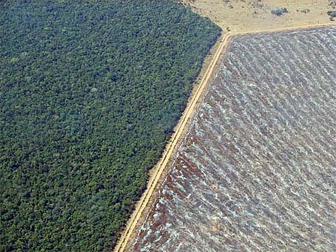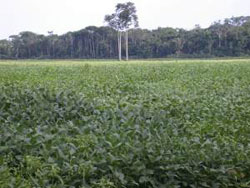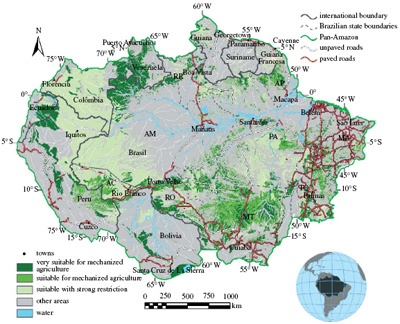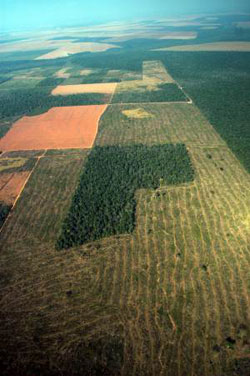Cellulosic energy may trigger dramatic change in the Amazon
Cellulosic energy may trigger dramatic collapse in the Amazon
Rhett A. Butler, mongabay.com
March 11, 2008
|
|
Next generation biofuels may trigger the ecological collapse of the Amazon frontier and could have profoundly unexpected economic consequences for the region, warns a paper published in Philosophical Transactions of the Royal Society B.
Dr. Donald Sawyer, an associate professor at the Center for Sustainable Development at the University of Brasilia and an associate researcher at the Instituto Sociedade, População e Natureza, writes that “interacting with climate change and land use, the upcoming stage of cellulosic energy could result in a collapse of the new frontier into vast degraded pasture.” The shift could increase the incidence and severity of fires, reduce rainfall in key agricultural zones, exacerbate forest die-back and climate change, and worsen social instability. Sawyer says that while difficult to anticipate, the worst outcomes could likely be avoided be promoting “intensified and more sustainable use” of already cleared areas, minimizing new deforestation, and encouraging “sustainable use of natural resources by local communities.”
Historic land use in the Amazon
Sawyer reviews historic land use in the Amazon and Cerrado, breaking technological change in the region into four stages: extraction, agro commodities, agroenergy and cellulosic energy. Extraction began first, after Europeans failed to cultivate sugar cane in the Amazon due to lack of labor and the discovery of other valuable commodities — including spices, medicinal plants, cacao, Brazil nuts and rubber — in the forest. Extraction of these resources was generally sustainable — resulting in little long-term forest damage — and increased until peaking with the rubber boom in the first half twentieth century.

Credit Aliança da Terra |
In the two decades following the collapse of the Amazon rubber trade due to the establishment of rubber plantations in Southeast Asia, the region was an economic backwater. Then in the 1960s, government development initiatives — including infrastructure expansion and financial inducements for farmers — coupled with agricultural innovation lead to the second stage of Sawyer’s history: the growth of agro commodities, especially cattle and soy.
“The replacement of extraction by agribusiness and commodity production, primarily for food crops and cattle for domestic consumer markets, as well as associated land speculation, generated deforestation reaching a record of 29 000 square km per year in 1994-1995,” he writes. “After 1990, there was a boom in soya and after 2000, a boom in beef, both intended primarily for global markets.”
The expansion of agro commodities led directly to Sawyer’s third stage: agroenergy.
Fueled by growing concerns about energy security and greenhouse gas emissions (though Sawyer notes that accounting for lifecycle impacts, most energy crops result in emissions comparable to those generated by conventional fossil fuels), global demand for biofuels began to surge two to three years ago. Increased demand boosted prices for all crops, providing greater incentive for agricultural conversion of natural ecosystems in the Amazon.

|
Sawyer says the shortcomings of agroenergy — notably competition with food and low yields — may lead to the forth technological change stage sometime around 2015: cellulosic energy. Feed stocks for cellulosic energy can be grown on marginal land not suited for grain or sugar cane, in regions closer to markets. Sawyer believes this shift could have profound changes for agricultural production in frontier areas.
“The key issue is how much energy is required to transform cellulose. If energy costs are not too high, and unless production and transportation costs can be reduced drastically, production of biofuel in peripheral regions or countries could lose its competitive advantage and become unprofitable,” he writes. “High-tech agricultural production of specific raw material like soya and sugar cane may be replaced by high-tech industrial processing of generic plant biomass, using the whole plant, not just its sap or seed.”
The impact of the rise of biofuels on the Amazon
Sawyer reviews several areas where the rise of agroindustry is having detrimental effects in the Amazon, before depicting a harrowing scenario for a future with cellulosic technology.
 Soy cultivation in Mato Grosso with forest remnant in background. Courtesy of WHRC |
While much is made of the impact of the growth of the soy industry in the Amazon rainforest, crop expansion has had a much greater impact on the neighboring savanna ecosystem known as cerrado. Sawyer cites research showing that cerrado is disappearing two to three times faster than rainforest in the Amazon: 22,000-30,000 sq km per year in the cerrado compared with 13,100 sq km in 2005-2006 and 9,600 in the Amazon in 2006-2007. In total “accumulated deforestation in the Cerrado is between 800,000 sq km and 1,600,000 sq km, depending on the estimate, as compared with 700,000 sq km in the Amazon, which is nearly twice as large.” Increasingly this conversion is for industrial soy and sugar cane production, says Sawyer.
Beyond forest and cerrado conversion, the rise of agroindustry in the Amazon is having other environmental impacts, including soil erosion, water depletion (the production and processing of one liter of ethanol uses much as 4 times the volume of water), pollution and sedimentation on local waterways, and increased greenhouse gas emissions. There are socioeconomic repercussions as well:
 Soil suitability map for mechanized agriculture in the Pan-Amazon region. Restrictions include slope (more than 2%), inundation risk and poor soil (ultisols, hydromorphic soils, sands and lithosols). Map from Nepstad et al (2008). |
“Concentration of land tenure continues or is exacerbated, since monocultures of cane and soya beans require large areas for mechanization and, especially in the case of sugar-cane processing, for sufficient scale. There is also concentration of income, given that producers and processors make large profits, while workers are displaced or earn low wages,” Sawyer writes.
“While soya beans eliminate employment, sugar cane involves temporary semi-proletarianization. Although mechanization is underway, 80% of sugar canes harvested in Brazil are cut manually by approximately 1 million seasonal workers,” he continues. “Work conditions are unhealthy, shortening working life and even causing death from exhaustion, due to manual cutting of sugar cane involving tens of thousands cutting strokes per day… Displacement and seasonal labor involve physical and cultural destruction of multifunctional family farms and traditional communities… Finally, although cane and soya in Brazil are different from maize in the USA, food prices are rising owing to competition for land and capital in the current context of expanding markets for grain and beef.”
Rising prices for cane and soy are competing with the dominant form of agricultural land-use in the region: cattle ranching.
“In addition to the direct and indirect effects of expansion of soya and cane monoculture, extensive cattle-raising is being displaced to frontier areas, where its area is multiplied, generating strong pressures for large-scale deforestation. Ranchers who sell their land to planters of soya or cane can purchase areas 10 times as large on the frontier, owing to the strong differential in land prices,” Sawyer explains.
“Although there are restrictions regarding clearing and planting soya and cane in the Amazon, there are no specific national or international policies or actions to limit the expansion of cattle-raising. The soya moratorium negotiated by Greenpeace in 2006 was restricted to traders agreeing not to purchase soya from newly cleared areas in the Amazon… There is no monitoring of deforestation outside the Amazon.”
Cellulosic ethanol: Doomsday ahead?
Sawyer suggests that the biofuels boom in the Amazon may be short-lived due to the emergence of cellulosic technology.
 Mosaic of forest and agriculture. Courtesy of the Woods Hole Research Institute |
“Owing to technical progress permitting production of cellulosic ethanol, the worst impacts of biofuels may come in the next decade,” he writes. “The apparent biodiesel and alcohol boom in Brazil could collapse into an empty frontier, not unlike the collapse of the rubber economy, except for the dimensions of its devastation. The result could be degraded land subject to fire, abandoned infrastructure, bankrupt farmers and unemployed seasonal workers. The Cerrado and the Amazon, no longer needed for production of carbohydrates or plant oils, could become vast degraded pastures.”
“Induced both directly and indirectly by climate change, dieback could result in economic bust, social unrest and political instability. With less rainfall being transmitted inland, desertification might result.”
Sustainability: a path for Avoiding Doomsday
While his scenario is dire, Sawyer argues there is still time to avoid the worst impacts of agroindustrial expansion in the Amazon. Starting with developed countries, Sawyer suggests a path towards ‘carbon neutrality’ through reduced consumption.
“Compensation for avoided emissions (e.g. planting trees) should be part of adjustment, rather than being a substitute for reduced consumption,” he writes.
In Brazil, Sawyer says short-term expansion of agroenergy production is “inevitable” but that “biofuels should be produced in sustainable ways in areas that have already been cleared and have low productivity” in order to minimize new deforestation. Agricultural intensification will further reduce the need to clear new land while improved governance could “improve environmental and social law enforcement and increase the costs of deforestation.”
Sawyer proposes that social reforms could go further in pushing rural communities toward sustainable livelihoods, by promoting the harvesting of renewable products like “native fruits and nuts, handicrafts, honey and medicinal plants.” Compensation for ecosystem services may be another source of income, especially through the creation of “policies that favor small farmers.”
“Market approaches should not be limited to certification, fair trade and carbon credits, which usually end up being very limited in scope and discriminating against poor and traditional communities,” he writes. “An alterative approach is to establish eco-social criteria for buyers, the most important of which would be to avoid new clearing anywhere. Developed countries could open their markets to sustainable products, buying good wood, non-timber forest products and non-forest sustainable products from communities.”
Sawyer concludes by calling for greater collaboration between scientists and policymakers at national and international levels.
“The responses to climate change and appropriate reactions to these responses involve crafting of appropriate policies, including scientific and technological policies, not limited to one biome, but reaching far beyond,” he writes. “Generating and disseminating environmental and social knowledge for public policy and political action require both national responses and international cooperation from the countries that have been most responsible for the accumulation of greenhouse gases and are now responsible for vast ecological footprints, reaching deep into the Amazon and the Cerrado.”
Donald Sawyer (2008). Climate change, biofuels and eco-social impacts in the Brazilian Amazon and Cerrado [FREE OPEN ACCESS]. Phil. Trans. R. Soc. B, DOI: 10.1098/rstb.2007.0026